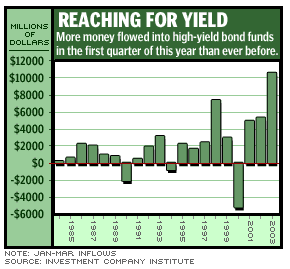NEW YORK (CNN/Money) - It looks like individual investors have finally kicked the stock habit. For the first quarter of this year they pulled money out of stock mutual funds -- something that hasn't happened at the start of the year since 1988.
But just because they don't like stocks anymore doesn't mean individual investors have gone cold turkey on taking risks. Even as they yanked money out of stocks, they were putting it into funds that invest in the high-yield bonds that are more commonly known as "junk."
In March, according to the Investment Company Institute, $5.4 billion flowed into high-yield bond funds -- more than ever before. For the first three months of the year, $10.5 billion has gone into junk (also a record); that's nearly equal to the $11.1 billion that exited stocks. In April, it looks like the junk bond party continued: according to fund tracker AMG, $2.7 billion flowed into high-yield funds in the first three full weeks of the month.
What's the allure of high-yield bonds? Mostly that it's worked. The Merrill Lynch High Yield Cash Pay Index has gained 12.5 percent so far this year, compared with the S&P 500's 4.3 percent. The average high-yield fund has returned 10 percent in 2003, according to Morningstar, compared with the 3.9 percent return of the average large-cap blend fund.
In essence, according to D.A. Davidson bond trader Mary Ann Hurley, the individual investor is doing what a lot of pros are doing. With returns so low lately -- whether we're talking Treasury bonds, savings accounts, or stocks -- and with people having become so accustomed during the bull market to seeing their investments make good gains, they're going into what are traditionally considered riskier areas of the market.

"They're reaching for yield out of lack of alternatives," she said. "After what's transpired over the past few years, people don't feel comfortable in the equity area, so they're moving into fixed income. But they want some yield for it."
But high-yield bonds offer higher returns for a reason. They're riskier -- rated at BB or worse, meaning, according to rating agency Standard & Poor's, that they are "regarded as having significant speculative characteristics." In other words, these are the bonds of companies that, if trouble comes, are mostly likely not to be able to pay back their debt holders.
"These are not investments for the grandma and grandpa set," said Hurley.
Nor are high-yield bonds anything like the screaming bargain they were a half year ago, in late October, when everyone thought the world was about to end. Back then, the Merrill index yielded about 10.2 percentage points over the 10-year Treasury. But after the big rally, junk bond yields have been pushed down, and the Merrill index yields just 6.4 percentage points over the 10 year. Investors aren't being paid nearly as handsomely for taking on risk.
The good news is that spread between Treasury yields and junk bond yields is not entirely out of line with past experience, according to Brown Brothers Harriman fixed-income portfolio manager Richard Koss, and it's not nearly as narrow as it's gotten when enthusiasm for junk bonds has been overdone.
"Given where spreads are relative to past history, they've gone from screamingly cheap to something close to fair value," Koss said. Still, "Being appropriately valued isn't the same as without risk," he noted.
What are the risks? There are several. The Fed could start tightening, which would raise the yields of safe bonds, like Treasurys, and pull money out of high-yield. Now that the war is over, there could be a flood of issuance of new bonds as businesses begin to spend more, and there might not be enough demand to meet the new supply.
But the big risk is that the economy turns down again, which would push another raft of companies with low bond ratings into bankruptcy and raise worries that many more were skating on the edge.
"If the economy turns down," said Kirlin Securities fixed income and economic strategist Brian Reynolds, "then junk is overvalued and the people buying it are going to get hurt."

|

